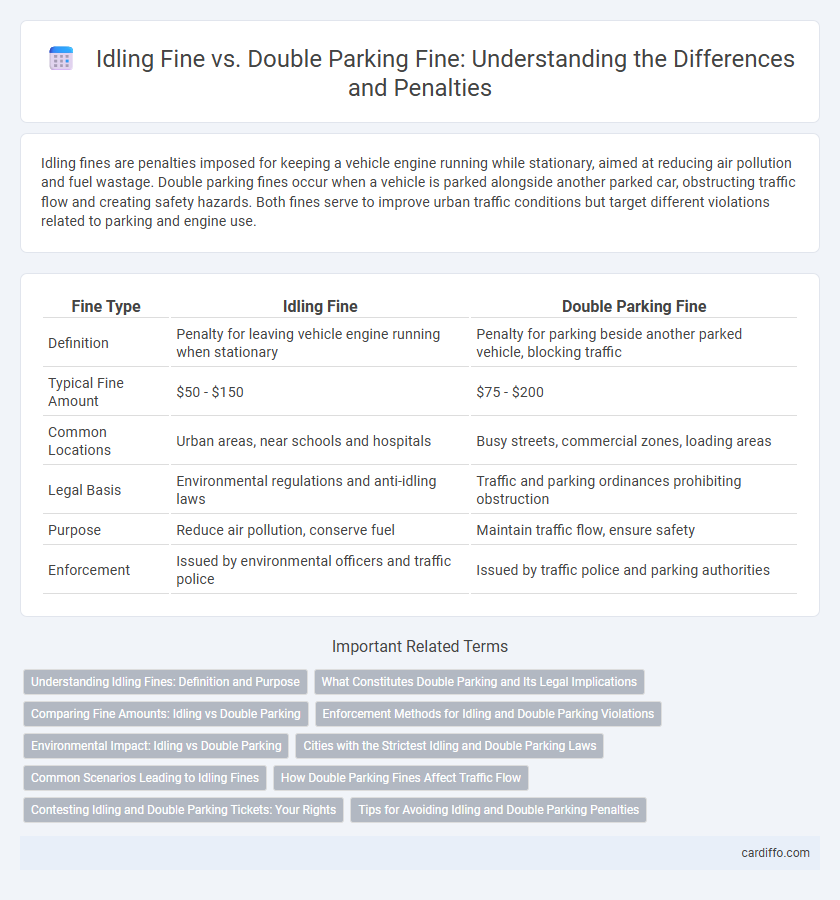Idling fines are penalties imposed for keeping a vehicle engine running while stationary, aimed at reducing air pollution and fuel wastage. Double parking fines occur when a vehicle is parked alongside another parked car, obstructing traffic flow and creating safety hazards. Both fines serve to improve urban traffic conditions but target different violations related to parking and engine use.
Table of Comparison
| Fine Type | Idling Fine | Double Parking Fine |
|---|---|---|
| Definition | Penalty for leaving vehicle engine running when stationary | Penalty for parking beside another parked vehicle, blocking traffic |
| Typical Fine Amount | $50 - $150 | $75 - $200 |
| Common Locations | Urban areas, near schools and hospitals | Busy streets, commercial zones, loading areas |
| Legal Basis | Environmental regulations and anti-idling laws | Traffic and parking ordinances prohibiting obstruction |
| Purpose | Reduce air pollution, conserve fuel | Maintain traffic flow, ensure safety |
| Enforcement | Issued by environmental officers and traffic police | Issued by traffic police and parking authorities |
Understanding Idling Fines: Definition and Purpose
Idling fines are penalties imposed for leaving a vehicle's engine running while stationary, designed to reduce air pollution and conserve fuel. These fines encourage drivers to turn off their engines during extended stops, minimizing unnecessary emissions and promoting environmental sustainability. Understanding idling fines helps motorists comply with regulations aimed at improving air quality and supporting public health initiatives.
What Constitutes Double Parking and Its Legal Implications
Double parking occurs when a vehicle parks alongside another parked vehicle, blocking traffic lanes and disrupting the flow of traffic, which is illegal in most jurisdictions. This violation often results in higher fines than idling since it poses a greater safety hazard and obstructs emergency vehicles and public transit. Legal implications include potential towing, impoundment, and increased penalties designed to enforce traffic regulations and maintain road safety.
Comparing Fine Amounts: Idling vs Double Parking
Idling fines typically range from $20 to $100 depending on local regulations, designed to reduce vehicle emissions and environmental impact. Double parking fines are generally higher, often between $50 and $200, reflecting the increased risk and obstruction caused to traffic flow. Comparing fine amounts shows that double parking penalties are consistently steeper than idling fines due to their greater impact on safety and congestion.
Enforcement Methods for Idling and Double Parking Violations
Enforcement methods for idling fines primarily involve the use of on-site inspections by traffic officers and automated sensors that detect prolonged engine activity without movement. Double parking violations are commonly enforced through traffic cameras and mobile patrol units that issue citations based on observed obstructions or reported complaints. Both fines rely on real-time monitoring technologies and citizen reports to enhance compliance and ensure accurate penalty assessments.
Environmental Impact: Idling vs Double Parking
Idling fines target vehicles that keep engines running while stationary, reducing unnecessary emissions and improving air quality in urban areas. Double parking fines address the congestion caused by vehicles blocking traffic flow, indirectly contributing to increased emissions from idling cars stuck in traffic. Enforcing these fines helps lower carbon footprints and promotes smoother traffic, leading to reduced overall environmental impact.
Cities with the Strictest Idling and Double Parking Laws
Cities such as New York, San Francisco, and Los Angeles enforce some of the strictest idling and double parking fines in the United States, with penalties reaching up to $500 for repeated offenses. In New York City, idling limits are set to three minutes, while double parking fines can exceed $115, reflecting the city's commitment to reducing traffic congestion and air pollution. San Francisco's stringent regulations include fines up to $250 for idling beyond two minutes and up to $150 for double parking, emphasizing the importance of maintaining smooth traffic flow and protecting urban air quality.
Common Scenarios Leading to Idling Fines
Idling fines commonly occur when drivers leave their engines running in restricted zones such as school areas, hospital entrances, or residential neighborhoods to reduce emissions and noise pollution. Double parking fines arise when vehicles stop alongside parked cars, blocking traffic lanes or pedestrian crossings, causing congestion and safety hazards. Understanding local regulations and signage helps prevent frequent violations related to idling and double parking in urban and commercial districts.
How Double Parking Fines Affect Traffic Flow
Double parking fines significantly impact traffic flow by reducing available lanes and causing congestion in busy urban areas. Vehicles double parked block through lanes, forcing drivers to merge abruptly, increasing the risk of accidents and slowing down overall traffic movement. Enforcing strict double parking fines discourages this behavior, improving road capacity and enhancing traffic efficiency.
Contesting Idling and Double Parking Tickets: Your Rights
Contesting idling and double parking tickets involves understanding your legal rights and gathering evidence such as timestamped photos or GPS data to prove compliance with regulations. Municipal codes vary, but many jurisdictions require clear signage and specific time limits on idling or parking restrictions, offering grounds for contesting unjust fines. Consulting local traffic ordinances and requesting a hearing can significantly improve the chances of overturning fines related to idling or double parking violations.
Tips for Avoiding Idling and Double Parking Penalties
Adhere to local regulations by turning off your engine when parked to avoid idling fines, as many cities enforce strict limits on engine idling time. Use designated parking zones and avoid stopping in active traffic lanes to prevent double parking tickets, which often incur higher penalties. Utilize apps or city parking guides to identify legal parking spots and monitor time limits effectively.
Idling Fine vs Double Parking Fine Infographic

 cardiffo.com
cardiffo.com